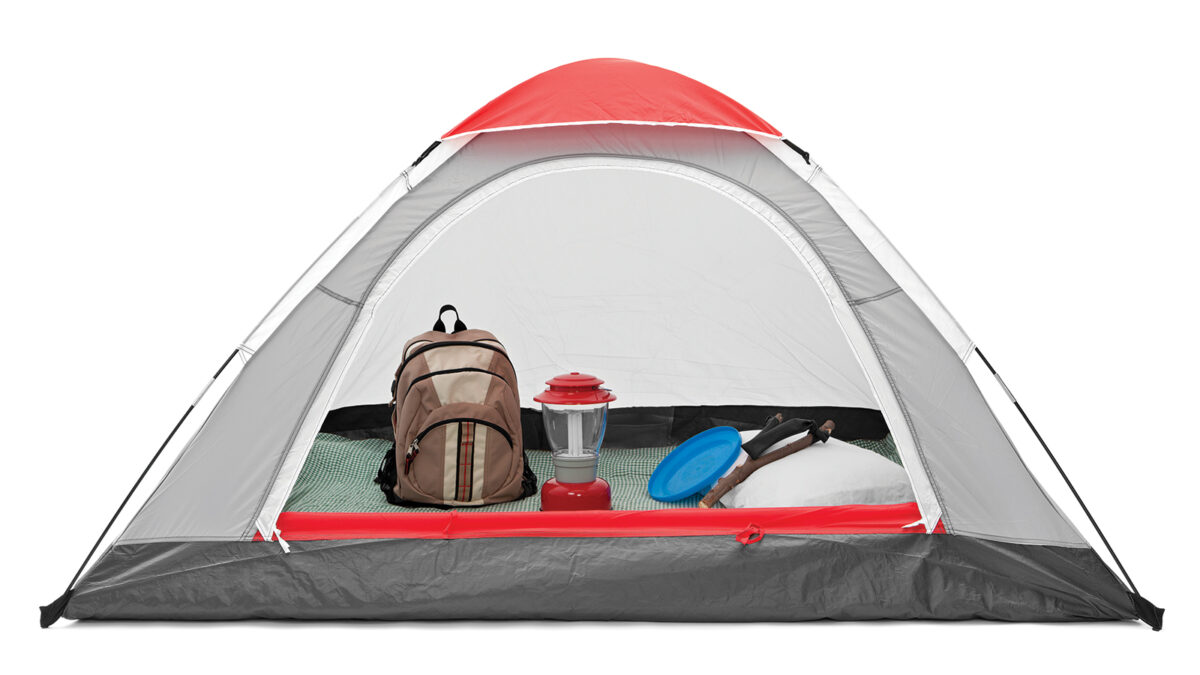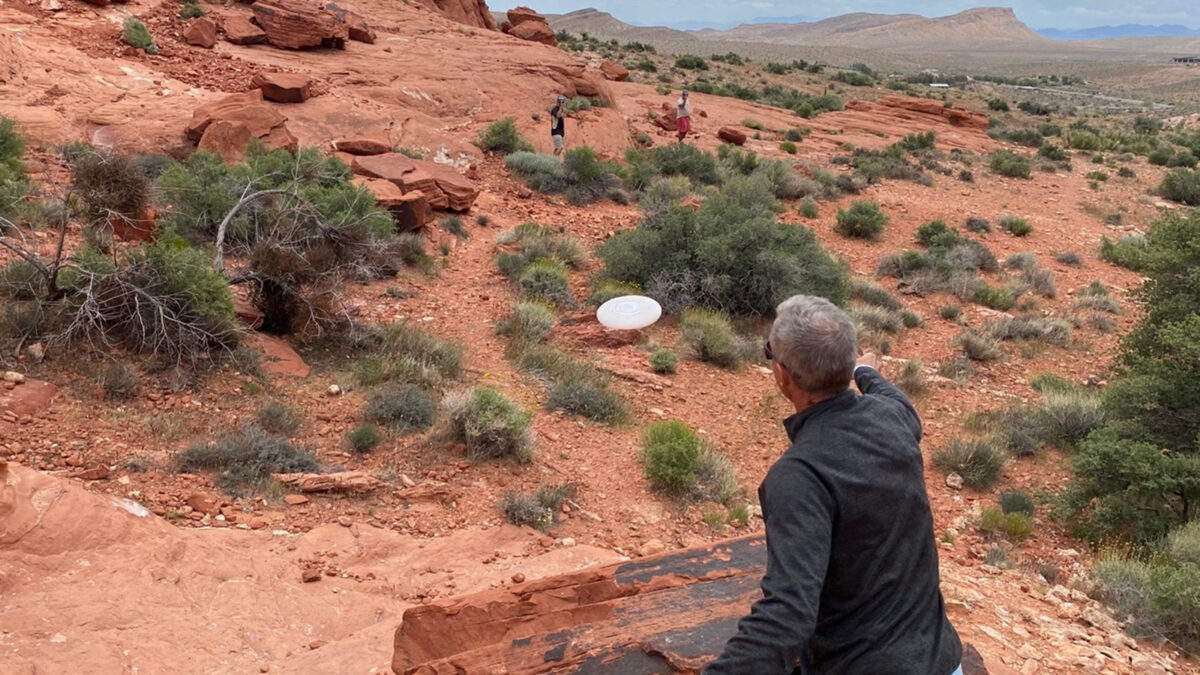
Wilderness Frisbee
August 2025
Download This Article (.pdf)
What sort of frivolous things do lawyers do in their spare time? In the late 1980s, my friend Walter Kingsbery and I created Wilderness Frisbee in the narrow and rocky confines of Bull Gulch, Colorado. Since then, this diversion has developed a cult following in the Southwest, its rules of play passed along by word of mouth. Although loosely resembling Wilderness Disc Golf, it is a completely different game, and a perfect accompaniment for any backcountry adventure or long day hike. You just need a flying disc. Maybe others have played this game or some variation of it but, if so, I have found no mention of it in print or online. Because I want to share the fun with others, this article describes the activity’s origins and summarizes the rules. At the heart of the game is its underlying spirit—not to disturb other folks or damage planet Earth or its fauna or flora while enjoying the game.
Origins
In about 1987, my friend Walter Kingsbery and I backpacked into Bull Gulch. Crossing the Colorado River on a train trestle, we chuckled as we recalled the scene in Stephen King’s Stand by Me when the young boys exploring the nearby woods needed to jump from a railroad bridge to avoid an oncoming train. We were not more than 20 yards off the trestle when a freight train came chugging around a canyon corner toward us. We hadn’t a clue until it appeared.
Bull Gulch is a twisting slickrock canyon located just north of the Dotsero interchange on I-70. After setting up camp above the canyon, we started tossing a Frisbee. An errant throw fell into the rugged red rock canyon, and we wandered down to retrieve it. We continued tossing the disc inside the canyon, skipping it off of or making it crawl along the relatively smooth, curving canyon walls. Eventually, we moved far enough apart that we could not see each other past the curves, and it was a lot of fun to guess where the other person was and to try to reach them on the fly. It was like throwing one blind dogleg after another. Once we perfected that, we challenged ourselves to see how many consecutive catches we could make. Over the course of the next few hours, we continued to refine things, until Wilderness Frisbee —or at least our 1.0 version of it—was born: rather than simply catching the disc, we tried to strike the other person with the Frisbee. We soon discovered that the game worked not just within the canyon’s bowels, but also while playing from side-to-side across the canyon cut. Then, we moved to some adjacent rolling hills dotted with chest-high dwarf junipers, and the game worked just as well. Over the years, we found that other than flat, treeless spaces, or very dense forest, most wilderness supplied an outstanding venue.
The game we developed that day 40 years ago in Bull Gulch has hardly changed, and its “rules” are set out below. Since then, we nearly always bring a Frisbee on our backpacking and camping trips. On these outings, we try to be courteous hikers first, and Wilderness disc players second. This has meant playing in a way that does not damage the environment or disturb other hikers, not even with the sounds of the game (mostly laughter). We simply won’t play if we risk either of these—and I hope that if you find this game intriguing, you will do the same. So, please, no trampling Utah’s cryptogamic soils; no playing in crowded public parks; no nothing that would give the game a bad name. My friends and I have found BLM land a good place to play—even though, yes, I will admit to playing a four-person match of a lifetime in an isolated part of Upheaval Dome in the Island in the Sky section of Canyonlands National Park. I also often play in the Boulder Mountain Parks if I’m sure I won’t disturb other people. Alaska was great because, well, there is so much freaking wilderness—but the moose were a problem. And 35 minutes from the Vegas Strip is Calico Basin—another fun location. Desert canyons, mountains, forests—just about anywhere but a beach works well. Even Prospect Park in Brooklyn was great—we set ourselves up far away from anyone else.
One reason the game fits so nicely with our hiking trips is that playing forces you to explore small areas and notice little things. As you’ll see when you read the rules, the playing area remains, quite naturally, relatively confined (backing someone into a canyon wall is good strategy, as ricochets double your odds of a winning throw), and we often play an entire game in the same area but from different angles and starting places. Inevitably, while retrieving errant discs, we pick up on all sorts of small details around us, and local animal and plant life, we might otherwise miss. It is, oddly, and surprisingly, very Zen. And, at my current age of 67, this diversion makes me feel like a kid.

Rules
Wilderness Frisbee usually involves two players, although a four-player variation exists. In the two-person game, a single Frisbee or other flying disc is used. Instead of a Frisbee, we might sometimes carry a 200-gram Zephyr, since smaller, denser discs can hurt players and the surroundings.
The playing area consists of any rugged wilderness location that includes natural features, such as reasonably spaced trees, boulders, rock walls and outcroppings, waist-high brush, canyons, and the like. While the game can be played in public parks, cities, and residential developments, such play is not within the sport’s original intent and is generally discouraged to avoid disturbing or striking others. The players begin by standing reasonably far apart with some natural obstacles between them, ensuring that the person with the first throw has a theoretical chance of scoring an out, but that it would take a terrific throw to do so. The object of the game is to throw the flying disc so that it touches the other player’s person, which can include any part of their body or clothing. Contact can occur while this disc is in flight, or by the disc skipping off or rolling along the ground, or after it ricochets off a rock, tree, or other object. Every time contact is made it counts as an “out” against that player, and once a player incurs the agreed-upon number of outs (usually three or five), the game ends. If the player at whom the flying disc is thrown moves even a little bit as the disc approaches, such a flinch is registered as an out even if the disc does not make actual contact.
If the thrown disc does not make contact, then the player at whom the disc was tossed goes to the spot where the disc comes to a complete rest, and throws the disc back at the other player from as close as possible to, but always behind, the disc’s resting spot, and the round continues this way until contact is made. Once contact is made and an out is registered, the players take turns establishing new separated starting positions to begin another round. (Sometimes a disc may end up in a clump of bushes or boulders. The player must throw from that spot, as uncomfortable as it might be. Throwing out from there accurately may be difficult, but the brush and boulders probably will help shield you from your opponent’s return throw.)
The preferred flying disc is a 150 gram or heavier “garbage can lid” Frisbee, not the smaller, denser discs typically used for disc golf. The reason for this is to minimize damage to the environment and possible injury to the players. If the flying disc lands in a tree or inside a bush or on a rock ledge, and is unplayable or unsafe to play, the player at whom the disc was thrown retrieves the disc and selects as close a location as they can to the original landing spot to throw from as allows sure footing, and without trying to gain an advantage.
Because the game is played in the wilderness, players should try to strictly avoid any damage to or disturbance of the environment, and should never play in sensitive study areas, or where the game might disrupt the peace. In addition, because a disc may be poorly thrown or strike an obstruction, it may come to rest relatively close to the thrower, resulting in the other player having a pretty easy return throw to score an out. In making such throws, in making any throws, however, the thrower cannot toss the disc any harder than is reasonably necessary to touch the other player. Purposefully throwing harder than necessary with the intent of getting the other player to flinch (or to hurt the other player!) is not cool. When throwing from a distance, however, it is usually necessary to throw the disc with some speed and strength, and this is acceptable. Because long throws could really sting the other player, it is common for that player to assume the “Wilderness Frisbee” position, which consists of standing sideways to the thrower, and placing the thumb side of one hand in front of the face (protecting the nose), with the other hand either flat below the waist or across the chest for additional protection. In this position, you are less likely to flinch. If the disc strikes either hand, however, it registers as an out.
With four players, two flying discs are used, with teams consisting of two players each. The teams alternate throwing the discs at one another, with both teams’ members reasonably separated from one another at the start (but not too distant). Both team members may throw their discs at just one of the other team players. If both discs miss, the other team members choose between themselves which disc each will throw. If one team member is struck, that team member must sit out the rest of that round, and the game continues two against one, with both discs in play. The single player chooses to throw from whichever of the landing locations of the two discs thrown by the other team they prefer, and throws both discs from that single location. The “sitting” player from the single thrower’s team helps retrieve the second disc for the teammate to throw from their preferred chosen location. The four-person game continues until touches are registered against both players from one team, resulting in an out against that team.
Parting Words
I am a very amateur disc golfer. I grew up playing the “ancient” course on the University of Colorado at Boulder campus beginning in 1979 with my law school classmate Charlie Davis, where the hole layouts and pin locations (trees, light poles, fountains) had been passed down friend-to-friend since the 1970s. (I’ve visited the “original” Oak Grove disc golf course near the Jet Propulsion Lab in Pasadena.) I didn’t play a course with chain baskets until the Thraemoor Invitational in Lakewood in the late 1980s (and I never got to wear the green jacket). Over the last 20 years, I have been playing many of the great disc golf courses found in Colorado. Some of my favorites are Conifer’s Beaver Ranch public course, Paulie’s Bucksnort private course in Pine, Wondvu up Coal Creek Canyon, and Cross Creek Disc Golf near Gypsum. I promise you this: Wilderness Frisbee is an inexpensive, easy-to-play game that competes with the disc golf experience. Give it a try! (And please take care not to disturb others or damage anything.)
______
The SideBar is an informal space where members can share their experiences, offer practical advice, share law-related stories, and take a lighter look at the law. Send your SideBar submissions to Susie Klein at sklein@cobar.org.


